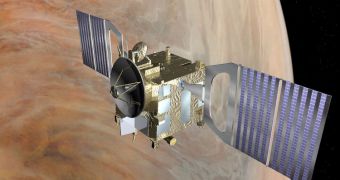Venus may be currently decreasing its rotation speed, for unknown reasons. Recent investigations conducted using the European Space Agency's (ESA) Venus Express orbiter revealed that the location of surface features was slightly changed from where it should have been.
Observing the surface of our neighboring planet is not an easy task, considering the thick cloud masses that cover the sky. Therefore, Venus Express had to use its infrared instruments to pierce those natural obstacles. Based on available data, researchers were expecting to find a certain layout.
However, the images the orbiter sent back to Earth revealed a slightly different arrangement, suggesting that the planet may be slowing down as it spins around its own axis. If the discovery is confirmed, then this could have significant implications for planetary studies.
The study was conducted using the Visible and Infrared Thermal Imaging Spectrometer (VIRTIS) instrument aboard Venus Express. It is capable of conducting observations in a portion of the electromagnetic spectrum, ranging from near-ultraviolet to infrared.
Its primary mission is to analyze the temperature levels on the Venusian surface, to study the interactions that develop between the surface and the atmosphere, and to shed more light on how the planet's atmosphere is layered.
Surface features that the team wanted to analyze during the latest observations session were found to be located about 20 kilometers (12.4 miles) away from where they should have been. The rotation rate for Venus was established by the NASA Magellan spacecraft, about 20 years ago.
Through studies such as this one, investigators can accumulate sufficient data to figure out whether the planet has a solid or liquid core. In turn, that can reveal more clues about planetary formation in general, and also about how our solar system evolved.
One of the most interesting aspects of Venus is that its atmosphere is dense and heavy enough to actually influence the planet's rotation rate, through friction forces. The Venusian atmosphere exerts about 90 times the pressure our own atmosphere does on Earth's surface.
When the Magellan and Venus Express “maps did not align, I first thought there was a mistake in my calculations as Magellan measured the value very accurately, but we have checked every possible error we could think of,” Nils Müller explains
The expert holds an appointment as a planetary scientist at the German Aerospace Center (DLR). He is also the lead author of a new research paper detailing the findings.

 14 DAY TRIAL //
14 DAY TRIAL //